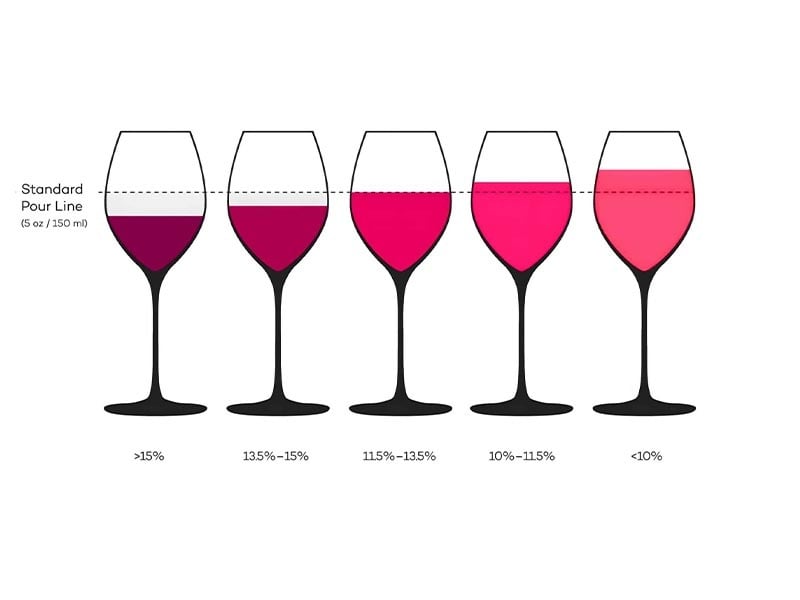ABV: What Is It? And Why Should I Care?
- Posted on
- Posted in California, Portugal, Riesling, tourigia national, zinfandel
- 0

Most of the readers of this blog probably already know that ABV stands for Alcohol By Volume, but there may be a few who didn’t know … till now. And, logically, the higher the ABV, the stronger the drink.
Measuring alcohol had its start in the 16th Century, when England added a tax on “proof spirits” that contained a high amount of alcohol. They estimated the ABV by soaking a gunpowder pellet in the liquor in question, then ignited it. If it burned, it was deemed strong enough to add the tax.
The reason it’s good to know a beverage’s ABV is that it’s a way to figure the effect a drink may have on you. Knowing a drink’s alcohol content before you imbibe lets you set a cut-off point, so you don’t drive under the influence, for instance, or dance with a lampshade on your head. But there are other reasons this knowledge is helpful. Typical wines will have an ABV at or below 16 percent, while fortified wine ranges from 15.5 percent to 25 percent ABV.
A glass of wine that only has a 7 percent ABV has half the amount of alcohol as a glass with 14 percent, which is an essential difference a consumer must understand. Not only does the ABV percentage affect how much alcohol you are drinking, but it can also affect the taste and body of the wine you are consuming.
The taste of a wine will be different for each person who drinks it. Think of it this way: Some people love broccoli, for example, while others can’t stand it. Some people will drink wine only with an ABV of 10 percent or lower, while others like it with 15 percent or higher.
A wine’s ABV also impacts its body. The “body” of wine means how heavy or light the wine feels. Alcohol content is the single biggest factor that changes a wine’s body. It can make it feel thick and filling, or smooth. If one prefers a lighter taste when drinking, choose a wine with a lower ABV. For a thicker, fuller wine, opt for a wine with a higher ABV rating.
The higher the ABV the dryer (or less sweet) the wine is; the lower the alcohol percentage, the sweeter the wine can be. Think of it this way: Yeast eats the sugar in the juice, which creates heat, carbon dioxide, and alcohol. The more sugar the yeast is allowed to eat, the more alcohol there is in the wine. Consequently, the dryer the wine. The riper the grape, the more sugar in the grape at harvest, the higher the potential alcohol.
So then logically, when making sweet wine, the winemaker must control and stop the fermentation, by chilling the wine, as in the case of Rieslings. Here the situation is such that acidity in Rieslings is so high, it needs a bit of sweetness to set it a balance. Here, the alcohol is low and does not add much to the body, mouthfeel, or texture. The resulting wine has a lightness about it. Even the sweetness of dessert style wines can have a lightness give the lower alcohol and higher acidity.
On the flip side, Port is a sweet wine that does draw body, mouthfeel, and texture from high alcohol. The wine is fermented to about 5 or 6 percent ABV and then fortified to stop the fermentation process. Most commercial yeast can only survive in an environment up to 16 percent ABV. Typically, the fortifying spirit is grape-based. While port is sweet and the varietals used do have high acidty, the resulting wines have weighty viscosity as a result of the higher ABV and the higher sugar.
There are examples of varietals that can reach 16 percent or more total ABV without being fortified. The California Zinfandel gains tons of sugar if allowed to. So here the weightiness is a result of unconverted left-over sugar, the fruitiness of the varietal, hidden proteins, tannins, and of course the ABV.
Choosing a good bottle of wine for your acquired taste preferences can be a learning process. Understanding what a wine’s ABV is will help you choose one based on your preferences. No bottle of wine is strictly better or worse than another; flavor profiles are based on what you prefer. Remember to choose a lower ABV if you like a lighter wine, or a higher ABV if you like fuller wines. And keep testing different flavors to find your favorites!

Comments
Be the first to comment...